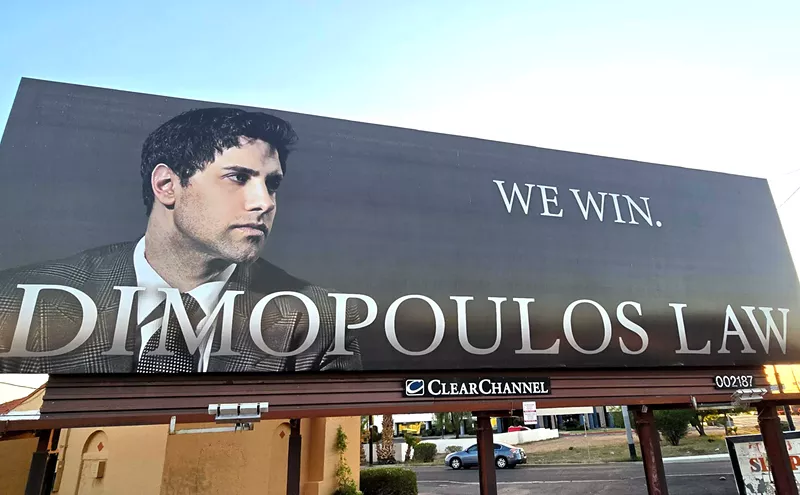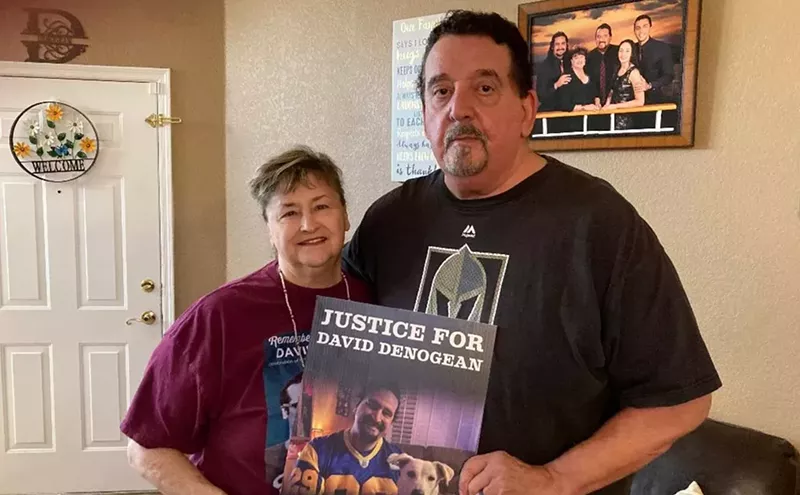The 28 days Christopher Quaratino spent in a spooky-looking house in Amityville, New York, defined his life.
Quaratino was just 7 when he and his family moved into the 4,000-square-foot Dutch Colonial home on Ocean Avenue in the Long Island town in 1975.
Now, at 43, he's still creeped out.
And not just by the ghost he saw.
Quaratino, a Phoenix resident who changed his last name in 1989 from Lutz back to the name of his birth father, is disgusted by the Amityville Horror legend, which he estimates has generated about a half-billion dollars in the past 25 years. From the first book in 1977 by the late Jay Anson, who billed the family's experience as a true story, the retelling of America's best-known haunted-house story in print and at the movies has distorted and fictionalized events nearly beyond any semblance of truth, he says.
After the Lutz family famously fled the home in a rush and moved across the country to San Diego, Quaratino and his siblings "took a lot of flak" from other kids.
"Your mother's a liar!" Quaratino recalls one kid saying to his face at school.
His mother, Kathy Lutz, told him to avoid reading Anson's book or seeing the subsequent 1979 movie starring James Brolin and Margot Kidder. So he didn't, not for a long time.
"She wanted me to grow up and be a normal kid. That would have been my heart's desire. I never wanted to talk about it. But my privacy had already been breached," he says.
Quaratino set up a meeting for this story at Bistro 202, the restaurant at the San Carlos Hotel in downtown Phoenix. That would be the supposedly haunted San Carlos Hotel, which sports its own Ghost Lounge and Restaurant next to Bistro 202. His cousin, Bobby Sylvester, also was there on the sunny outdoor patio. Quaratino's a short man, dressed in shorts and an untucked T-shirt, with dark hair and a black beard dotted with white. He's an air-conditioner repairman and home renovator. He has an easy-going demeanor and speaks hesitantly at times, as if wary of burdening his great psychological weight on others. His cousin's taller, has a New York accent, and wears a polo shirt and an amulet of a dragon on a chain around his neck.
Quaratino has kept a relatively low profile most of his life, but this isn't the first time he's come out with concerns. Most of his media time has occurred since 2005, when the remake of the original film was getting promoted. One headline in Long Island's Newsday that year stated that he "debunks" much of the legend.
True, but he doesn't debunk everything.
Quaratino remains convinced that an evil presence stalked the family in the Amityville house. A deeply religious man who once considered becoming a Christian pastor, Quaratino believes his stepfather, George Lutz, invited demonic forces into the home through his dabbling in the occult.
He lived in the home when he was 7 and remembers the fear he felt there.
His parents had been informed by a real estate agent before they moved into the house in December 1975 that a ghastly mass murder had occurred there. About year earlier, a 23-year-old man had shot to death his parents and four siblings as they slept in their beds. Quaratino remembers standing in the dwelling's basement for the first time with his parents and asking where the "bodies" were.
Once, he and his older brother, Daniel (9 at the time), noticed that one of the signature quarter-circle windows on the second floor kept opening, even after they had latched it several times. The family dog seemed to sense malevolence from day one, he says, and tried to jump over a fence while still leashed. His dad rescued the spasming animal as it hung from its neck.
Then, one night, a dark, human-like figure appeared in his bedroom doorway. He could see what seemed like the outline of a head and body.
"It was as large as a man, as definite as a shadow, but not against the wall," he says. "I saw no feet, and it petrified me.
"I remember being so scared [that] I wanted to cry out, 'Mommy!' but I knew Mommy was too far away to get to me before it did."
He says the shape advanced toward his bed.
And faded away, leaving a lingering stench.
He's positive this was no dream.
Quaratino's turned out to be the second ghost story of the day.
Before leaving Bistro 202, a staff member behind the counter at the cafe is asked whether she's heard about any sightings of the hotel's ghost.
"Yes," says Laura Lechuga with an embarrassed smile. A worker retrieving some items from an upstairs storeroom heard someone whispering to her, she says. The worker couldn't make out any words but felt the hair over her ear move, as if blown by an invisible breath. There was no one else in the room, Lechuga says. She adds that a few weeks ago, another employee claimed to have seen an eerie figure in white moving up the stairs.
Quaratino, listening to Lechuga's story, nods solemnly.
This is the paranormal world in which he's always lived.
As a campfire tale or fodder for a scary movie, the Amityville Horror has a lot going for it.
Clearly, the iconic house's anthropomorphic appearance is partially responsible. The upper-floor quarter-circle windows looked like eyes on a jack-o'-lantern. (But no longer: Years ago, the place was renovated by owners tired of the never-ending parade of gawkers and ghost-hunters in the small town and replaced the quarter-circle windows with boring rectangular ones. The house was sold last year for $950,000.) A similar house in New Jersey used for the 1979 movie completes the face-like look with an attached chimney running between the "eyes."
The name of the Long Island town, where residents abhor the legend and its believers, adds to the mystique: Amity means friendship, an irony not lost on those who think evil lurks there.
The tale of terror came just years after the enormously successful The Exorcist book (1971) and movie (1973), and America was primed for a new wave of modern horror tales. (Carrie, Stephen King's first published novel, came out in 1974.) The chilling, Oscar-nominated music in the 1979 Amityville Horror movie, featuring the airy la-la-las of young girls, has become a cliché of the horror genre.
Anson's book has sold an estimated 10 million copies since its release 24 years ago, but its popularity has waned, and it's not easily found in local bookstores. Still, it would be wrong to say the legend it spawned is dying.
Besides numerous books, the "horror" has led to nine movies. No fewer than four more movies currently are in various stages of production, including: Amityville: The Legacy in 3D; Amityville Horror: The Lost Tapes; Shattered Hopes — the True Story of the DeFeo Murders; and a documentary, My Amityville Horror, which centers on interviews with Quaratino's brother, Daniel.
The main reason for the enduring idea that the house is haunted stems from Ronald DeFeo Jr.'s horrific crime. Even in today's jaded culture, the slaying would be a national story. DeFeo, a mentally troubled heroin addict, shot his six family members with a rifle as they slept in their beds in various rooms. Oddly, all the victims were found lying on their stomachs, and none appeared to have been awakened by the gunshots.
George Lutz, then 28, moved into the house on December 18, 1975, with his new bride, Kathy, and her three children. She was a waitress, and freshly divorced. Lutz met her in a Babylon, New York, diner he frequented, says Quaratino. The kids — Danny, Christopher, and 5-year-old Missy — liked George. He owned a land-surveying business and could pull wheelies on his Harley-Davidson. The family order crumbled years later under disputes and bad feelings, but not before George and Kathy had two daughters together.
Anson's book says the freaky stuff began the first morning after the Lutzes moved in, when George heard someone — something? — pounding on his front door at 3:15 a.m.
Legend has it that the problems soon grew outlandishly. Critics later complained that the Lutzes' story conveniently includes nearly every paranormal activity known: Unexplainable coldness. Levitation. Ghostly apparitions. Lots of rapping and tapping sounds. Mysterious music from an unknown source.
A Catholic priest brought in to bless the house supposedly heard a voice telling him to "get out." The priest backed up the story during an appearance on the 1970s show In Search Of, hosted by Leonard Nimoy.
A ceramic lion supposedly bit George on the calf. Little Missy suddenly began playing with an invisible friend, Jodie. Jodie was a pig that George claimed to have seen. From Anson's book:
From Missy's second-floor bedroom window, George could see the little girl staring at him, her eyes following his movements. "Oh, God!" he whispered aloud.
Directly behind his daughter, frighteningly visible to George, was the face of a pig! He was sure he could see little red eyes glaring at him!
On a stormy night in mid-January, the Lutzes claim in the book, the spookiness reached a terrifying climax. The house became freezing cold. Doors and drawers banged opened and closed. The boys' beds were sliding across the room. A hoofed creature stood on top of George in his bed, trapping him until he "passed out from fright. When he awoke, his terrified boys were trying to get him out of bed:
As he lay there, George asked Danny, "What's the matter? What's in your room?"
"It's a monster!" Danny cried. "He doesn't have any face!"
"It tried to grab us," Chris broke in, "but we ran away! Come on, Daddy, get up!"
On the top step stood a gigantic figure in white.
George knew it was the hooded image Kathy had first glimpsed in the fireplace. The being was pointing at him!
As if fleeing from a house fire, the family grabbed a few items, ran out, and supposedly never set foot in the home again. All five family members moved into Kathy's mother's small bungalow in nearby Babylon. Fearful even of their belongings, they sold off their furniture and other items. Their fleeing made the local newspaper — the first story in what would soon become a media frenzy.
Less than two months later, the Lutzes held a press conference with William Weber, an attorney representing DeFeo, leading to accusations that they'd planned a hoax before even moving in. Weber wanted to play up the idea that evil spirits were in the house — or, at least, that DeFeo thought were there — in an attempt to have DeFeo declared guilty but insane.
In a later legal dispute, Weber claimed he and George Lutz concocted the whole story "over many bottles of wine." But believers point out that he had an incentive to trash Lutz, since they were suing each other. In a contract for a book proposal Lutz and Weber considered, Weber wanted Lutz to agree to take a lie-detector test — something he arguably wouldn't have done if he knew it was a hoax. (George and Kathy ultimately took lie-detector tests from a nationally recognized firm — and passed them.)
George Lutz contacted Stephen Kaplan, a paranormal researcher, but the two had a rapid falling out, and Kaplan spent the next 20 years debunking the Amityville story.
The Lutzes then met Anson and turned over to him a series of tape recordings they'd made, describing the ghostly events. He produced the book from these recordings and suggested in the book's afterword that he'd attempted to verify the alleged facts. Critics like Kaplan scrutinized every line in the book and found countless flaws. Weather reports revealed no snow had fallen in Amityville on the day George claimed to have seen Jodie's huge, cloven tracks in their snow-filled yard, and that no storm had occurred on the day they fled the place. The book stated that the front door had been blown off its hinges, but the home's new owner went on TV to show it was in perfect shape. A mysterious "red room" was just a closet under the stairs. And so on.
The controversial concept that any part of the family's story is or was true continues to this day. Both surviving Lutz boys (Daniel kept his stepfather's last name) say they are now telling the "real" story of what happened, which only adds fuel to a ceaseless online debate.
The perpetual argument of whether the horror was or wasn't a hoax (or if it wasn't a hoax, which parts were or weren't true) vexes Quaratino, who believes he should be considered an authority on the subject. But he hasn't proved savvy when it comes to public relations or dealing with movie-studio types.
He's watched as filmmakers and authors raked in the cash over the past two decades, sometimes depicting or mentioning him as if they really knew something about him. No matter how hard he's tried, he's been unable to steer the narrative — or the profits — his way.
Trapped in an American ghost story of his stepfather's making, Quaratino learned he couldn't beat them — or join them.
He's only a fictional character to Hollywood.
Jay Anson, who secured the movie rights for his book, made tens of millions of dollars on the Lutzes' story. Both the original movie and MGM's 2005 remake grossed more than $100 million. Quaratino's claim of what could be called a half-billion-dollar cottage industry from his family's story might not be far off.
He estimates his parents earned $400,000 to $450,000 over their lifetimes because of the Amityville Horror. After the release of Anson's book, the Lutzes moved to San Diego, then Phoenix. They divorced in 1988. The next year, Christopher, after incessant teasing by fellow soldiers (he served in the Army's 10th Mountain Division in the first Gulf War) officially changed his last name from Lutz back to Quaratino.
"After that, I never wanted anybody to know who I was," he says.
(Now that he wants to make a movie, part of his e-mail address is amityvillekid, though.)
Over the years, the exaggerations about the long-ago events in Amityville snowballed in the movies.
Quaratino says he would ask his stepdad, who died in 2006, about the ridiculous things in the 1979 film and its sequels, and George would always tell him that the movies were full of bunk — but that Anson's book was authoritative.
Quaratino read it for the first time in 1999, before he was interviewed for a History Channel special on the Amityville Horror.
He was flabbergasted by the nonsense even in Anson's work.
"Now I'm seeing why the public perceives this as a hoax," he says. "What I'm reading, to me, is bullshit."
He went off on his mom, he recalls, which he feels "terrible" about now. She died in 2004 of emphysema.
Quaratino went public in the early 2000s, writing online that not only had George apparently lied about parts of the tale, but that the true parts came about because of his stepfather's dabbling in the occult.
Quaratino believes that his stepdad — whose experience with the occult was limited to a few books he'd read — intentionally repeated the names of demons during meditation sessions, calling malevolent forces to the home. That explains why the Lutzes reported that supernatural events followed them after they left Amityville (the Anson book states that George and Kathy levitated at their new residence and saw "green slime" moving up stairs) and why no one living in the Ocean Avenue house subsequently reported any problems.
Whatever the cause, bad feelings festered in the family. George and his stepsons fought over the rights to use the family's images in later entertainment projects.
In 2003, Quaratino, hoping to cash in from online interest in the legend, registered the domain name www.amityvillehorror.com. But George, who'd had the phrase "Amityville Horror" trademarked the year before, sued him. Quaratino countersued, noting that the trademark said the brand name concerned "a series of nonfiction books," even though George had admitted publicly that at least parts of the series were bogus. Stepfather and stepson ultimately settled the suit, and Quaratino turned over the domain name.
Around the same time, Quaratino found out that George was working on a deal for a movie in which Christopher came back to the home years later, became possessed, and killed his father. The notion offended Quaratino.
When MGM — which had obtained Anson's rights to use the family's story — announced plans to do the 2005 remake, George lost financing for his own film project.
In the 2005 MGM version, George is the one who gets possessed — and tries to kill his family.
"Karma came back and bit him on the ass," Quaratino says smugly.
George filed suit against MGM — it was settled the day he died.
George and Kathy Lutz went to their graves without recanting the idea that they'd experienced supernatural events.
"My personal opinion is that something happened to them," says Laura DiDio, who was a 19-year-old TV reporter when she interviewed the Lutzes in the '70s. "If their intent was to perpetrate a hoax or a fraud, they screwed up. The people who made all the money were Jay Anson and MGM."
DiDio, who now writes articles about the high-tech world, has kept in contact with the Lutzes, Quaratino included, and feels for the surviving kids.
"The real Amityville Horror is a 40-year-old story of human greed and fractured family," she says.
But she also hints that it's about something more. She saw things she can't explain.
In February 1976, when interest in the Lutz story was first growing, she attended what was later known as the "psychic slumber party" at the Amityville house with other reporters and paranormal researchers, including Ed and Lorraine Warren, then-famous "demonologists" who would help fuel the Amityville legend. She says she'll never forget how Steve Petropolis, a hard-boiled, New York-area TV reporter, suddenly bent over in apparent pain when he reached the top of the staircase.
"His face was ashen, he's doubled-over, and he's clutching his chest. He's got heart palpitations," she says. He'd never had a similar episode, he told everyone. Several of the supposed psychics holding a séance in the home also reported medical problems — headaches, nausea. While she could dismiss their claims as possibly fake, Petropolis' reaction surprised her, she says.
Then, days later, she returned to the Amityville home by herself and used a key George had given her to get in. She took her shepherd-lab mix inside. The Lutzes' personal items still were in the house. Food was rotting in the refrigerator. A gingerbread house the family had made for the Christmas season was still sitting on a counter.
"All of a sudden, I hear my dog growling. He's in the foyer, standing at the bottom of the steps. His eyes are fixed at something at the top of the steps. There was nothing there," she says.
She'd never heard the dog growl before.
It's possible that someone was hiding upstairs in the empty house, though how could anybody have gotten in? She figured it was time to leave.
Quaratino lives with his wife in a modest home near 23rd Avenue and Interstate 17 in Phoenix. A large painting on an easel of a weeping Jesus dominates the small living room. The unpainted patio cover in the backyard was hung incorrectly by the previous owners and appears unsafe, while bulky equipment from Quaratino's air-conditioning business sits on several metal shelves. Yet the backyard doesn't look inhospitable – it's a big space, full of grass, bordered by oleanders and trees, with a fire pit in the middle.
To help raise money for his movie project, Quaratino will hold a webcast from the yard on October 30, during which he'll tell a "real-life story" about some paranormal experiences he's had in the past few years. For a $5, viewers can watch and listen to Quaratino tell a story that is "creepy, or your money back."
(If you want to tune in, go to Quaratino's website, www.amityvillehorrorchallenge.com, before 6 p.m. Arizona time on Sunday, October 30, and follow the link to the live broadcast.)
With the funds he hopes to raise, he plans to find a documentary filmmaker and put together a movie that will educate the public — and, especially, what is now the third generation of Amityville fans — to what Quaratino calls the "truth."
His brother has beat him to the punch.
Before the 2005 movie, MGM offered him and his brother about $125,000 each for the rights to use their depictions in its upcoming movie and other future endeavors. Daniel took the money, while Quaratino — wanting control over such depictions — did not.
MGM made its movie.
Daniel found Eric Walter, a 26-year-old aspiring movie director, and put together their own project. It's called My Amityville Horror. In the movie, which Walter hopes to see making the rounds at independent film festivals next year, Daniel Lutz – interviewed on camera by Laura DiDio – relates how the Amityville legend has haunted his life. Several psychics are featured, as well.
The movie will be about paranormal events but also will have a "psychological viewpoint," Walter says. "The parents' belief that this happened to them amplified into the kids, as well. These were very young kids, very impressionable. To go for a lifetime telling yourself this happened — the demons in [their lives] became greater, more enlarged."
Walter says he asked Quaratino to get involved in their project, but the sibling — true to form — wanted to do his own thing.
DiDio, meanwhile, was stunned to learn last year that the planned Lost Tapes movie is about a young TV reporter plagued by violent, paranormal powers after attending a séance in the Amityville house.
DiDio wonders whether she should pull out her old notes and write her own movie.
With this yarn still stumbling forward after 25 years like some half-rotten zombie, it seems nearly everyone involved has had the opportunity, at least, to cash in.
Cousin Bobby Sylvester, who claims he once was stopped from going into the Amityville house to visit his cousins by an invisible force, even makes an appearance in Walter's film.
But Sylvester, who says he has a "background in promoting music," continues to serve as Quaratino's promoter and is helping set up the upcoming webcast.
"He doesn't trust anybody," Sylvester says of his cousin, Quaratino. "That's why I uprooted myself and came out here [from New York]."
"I've got a game plan," Quaratino states firmly. To keep control of the content, "I'd like to remain the executive producer of my film."
He wants no outside investors — and if there's a fortune to be made, the Amityville kid finally will be the one making it. Quaratino acknowledges, however, that investors in the movie probably would "want control," and if that's what it takes to get the movie made, so be it.
After all, Quaratino's also in this for the money he thinks he's owed for his family's ghost story.












